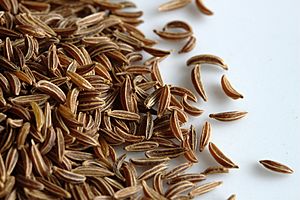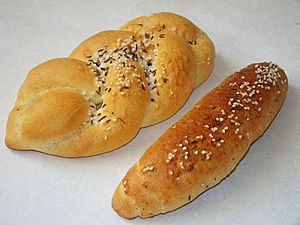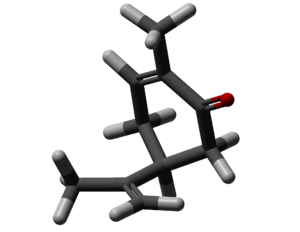Caraway facts for kids
Quick facts for kids Caraway |
|
|---|---|
 |
|
| Scientific classification | |
| Kingdom: | |
| Division: | |
| Class: | |
| Order: | |
| Family: | |
| Genus: |
Carum
|
| Species: |
C. carvi
|
| Binomial name | |
| Carum carvi |
|
Caraway, also called Meridian Fennel or Persian Cumin, is a plant known for its unique flavor. Its scientific name is Carum carvi. This plant is a biennial, which means it usually lives for two years. It belongs to the Apiaceae family, which also includes carrots and parsley. Caraway originally comes from western Asia, Europe, and North Africa.
The caraway plant looks a lot like other plants in the carrot family. It has delicate, feathery leaves that grow on stems about 20–30 cm (8–12 inches) tall. The main flower stem can grow taller, reaching 40–60 cm (16–24 inches). Small white or pink flowers grow in umbrella-shaped clusters called umbels. The caraway "fruits" (which people often call "seeds") are crescent-shaped and about 2 mm long. They have five light-colored ridges. Long ago, caraway was even used to flavor spiced drinks.
Contents
What is Caraway Used For?
Caraway fruits are usually used whole. They have a strong, anise-like taste and smell. This comes from special oils inside them, like carvone and limonene. Caraway is a popular spice in many foods.
Caraway in Food
- Breads: It's often sprinkled on rye bread and other types of bread.
- Desserts: You can find it in sweet treats like caraway seed cake.
- Savory Dishes: It's used in casseroles and often added to sauerkraut.
- Cheeses: Caraway adds flavor to cheeses like bondost, pultost, havarti, and Tilsit cheese.
- Drinks: It's an ingredient in Akvavit and other liqueurs.
Other Uses for Caraway
The roots of the caraway plant can be cooked and eaten like parsnips or carrots. The leaves are sometimes used as herbs, similar to parsley. You can eat them raw, dried, or cooked.
In Serbia, caraway is often sprinkled on homemade salty scones. In Middle Eastern cuisine, caraway pudding is a popular dessert, especially during Ramadan. Caraway is also added to harissa, a spicy chili paste from Tunisia. In Syrian cooking, it's used to make sweet scones called keleacha.
Besides food, caraway fruit oil is used in soaps, lotions, and perfumes for its scent. It can also be used as a breath freshener. For a long time, people have used caraway in traditional medicine.
Where Does Caraway Grow?
Caraway grows in almost all of Europe, except for the Mediterranean area. It is widely grown as a farm plant. Other types of Carum plants usually have smaller fruits. Some grow on rocks in mountains, especially in the Balkans and Italian Alps. But Carum Carvi is the only one that is widely grown. Its fruits are used in many ways for cooking, and its oils are used in some medicines and drinks.
Caraway plants like warm, sunny places. They grow best in soil that drains well and has lots of good nutrients. In warmer areas, it's planted in winter. In places with milder weather, it's planted in summer. There's even a special type of caraway that can live for many years.
Finland produces a lot of the world's caraway. In 2011, Finland supplied about 28% of all caraway. The climate and long summer daylight hours in Finland are perfect for growing caraway. This helps the fruits grow with more of the special oils that give caraway its flavor. Other main places where caraway is grown include Canada, the Netherlands, Egypt, and central Europe.
See also
 In Spanish: Alcaravea para niños
In Spanish: Alcaravea para niños




